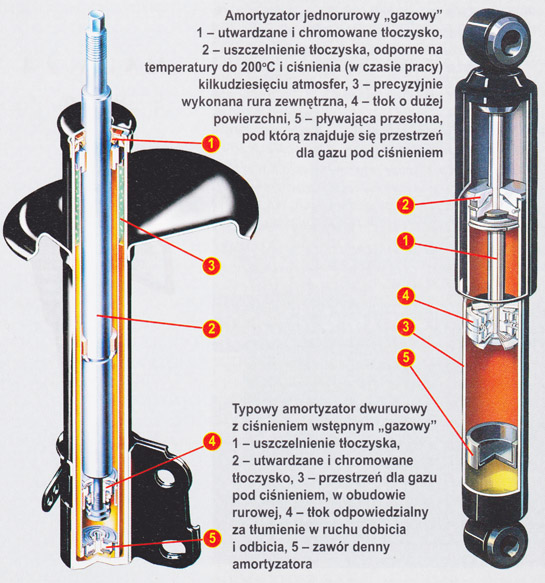 Please note, that in the shock absorber the piston and sealing elements wear the most. During the verification, the degree of wear is checked for the shock absorber rods, pistons and valves. When reassembling the shock absorber, all sealing elements are replaced with new ones. The correct operation of the shock absorber is usually assessed during a road test (in large repair plants, the operation of the shock absorber is controlled on a special device adapted to take off the performance characteristics). The car should then be observed visually, e.g. FSO Syrena, driving at a speed of approx 50 km / h on a field stone surface (the so-called. cat heads) with equal tire pressure 1,6 kG/cm2. In a car with good shock absorbers, the wheels are in contact with the road surface at all times, and the body moves smoothly without jolting or swaying. Rocking of the bodywork about a transverse axis (car FSO Syrena) and the lack of continuous-contact of the wheels with the road while driving over uneven surfaces proves poor damping of the shock absorber. On the other hand, too hard adjusted shock absorbers cause an increased frequency of suspension vibrations, with reduced wheel travel and no road contact. In this case, the vibration of the suspension transmitted to the body is easily felt by the driver.
Please note, that in the shock absorber the piston and sealing elements wear the most. During the verification, the degree of wear is checked for the shock absorber rods, pistons and valves. When reassembling the shock absorber, all sealing elements are replaced with new ones. The correct operation of the shock absorber is usually assessed during a road test (in large repair plants, the operation of the shock absorber is controlled on a special device adapted to take off the performance characteristics). The car should then be observed visually, e.g. FSO Syrena, driving at a speed of approx 50 km / h on a field stone surface (the so-called. cat heads) with equal tire pressure 1,6 kG/cm2. In a car with good shock absorbers, the wheels are in contact with the road surface at all times, and the body moves smoothly without jolting or swaying. Rocking of the bodywork about a transverse axis (car FSO Syrena) and the lack of continuous-contact of the wheels with the road while driving over uneven surfaces proves poor damping of the shock absorber. On the other hand, too hard adjusted shock absorbers cause an increased frequency of suspension vibrations, with reduced wheel travel and no road contact. In this case, the vibration of the suspension transmitted to the body is easily felt by the driver.